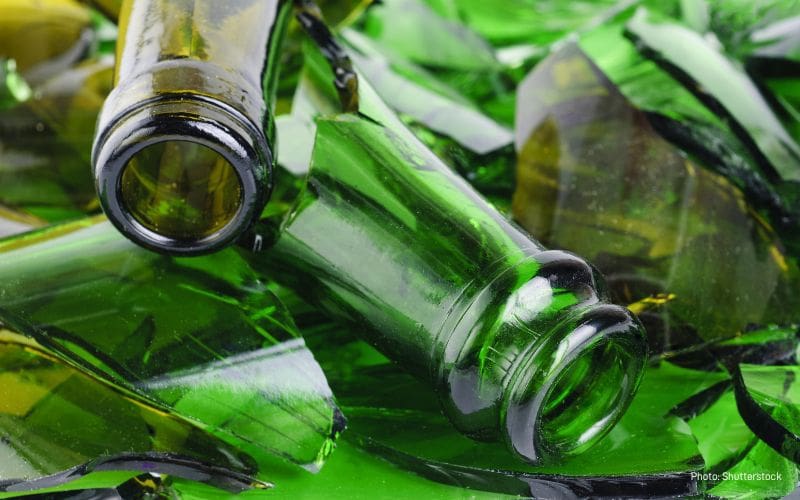
By expanding bottle bills, we can improve the recycling of valuable materials - like glass from wine bottles. Photo: Shutterstock.
I am no wine connoisseur. Whenever I find myself at the store overwhelmed by the number of wine options, I resort to a time–tested method that guarantees I’ll be pleased with my selection: I pick the prettiest bottle. Sometimes, I get to reuse it for a DYI project. More often, I place it in the recycling bin. But despite my best intentions, that beautiful bottle will likely end up in a landfill. How’s that possible? It turns out most glass collected through curbside recycling doesn’t get recycled. And here in Massachusetts, as in most states, bottle return programs don’t cover wine bottles. So, our options for recycling them are limited. That means they end up mixed with trash or littering our communities. But a solution exists.
Why Wine Bottles? More Than Just Good Looks
Wine bottles possess many qualities that make them perfect for recycling. Because of the requirements of wine, the glass used for wine bottles is much thicker, sturdier, and more durable than the glass used for other bottles. That makes it easier to keep intact, sort by color, and recycle.
Yet across the Northeast, most glass bottles – including wine – will end up as landfills cover. Waste companies place this layer of crushed glass scraps on top of the trash to prevent pests, deter odors, and keep waste from blowing away. So, that elegant wine bottle that spent just a few hours on your table will now serve an eternity weighing down trash. That also means our region’s landfills, already strained for space, become overburdened with these crushed bottles.
And let’s not forget about all the energy and materials needed to produce and transport high-quality bottles in the first place. It’s a real waste of resources to let something of such high cost in value end up being dumped – especially, when it could easily be transformed into a new product.
But a mystery remains: Why would the bottle I placed in my curbside recycling bin end up in a landfill and not a recycling facility, waiting its turn to become a new item?
The Problem with Glass Recycling
Let’s get something clear: Glass is 100% recyclable. And, unlike recycled plastic, which gradually degrades in quality, we can recycle glass into high-quality products even after many rounds. So, recycling as much glass as possible is a no-brainer. But the U.S. barely recycles 33% of all the glass produced. With 964 million gallons (~3.85 billion bottles) of wine consumed in 2022 alone, that translates to roughly 2.57 billion wine bottles dumped in landfills each year.
Here’s the problem: Curbside recycling does its best to ensure we can recycle glass. But, in the mix with other recyclables in the curbside bin, glass bottles can get crushed too finely or contaminated with grime. And no recycling company will take this crushed, dirty glass. That’s why so much glass ends up in landfills. So, while convenient, having a single bin for all recyclables leaves us with shattered hopes of one day seeing wine bottles get recycled into a new product.
Bottle Return Programs Offer a Solution
There’s a high demand for clean glass from manufacturers, but recyclers currently can’t get enough of it. Bottle bills help close that gap. When we return bottles at redemption centers through the bottle return program, they don’t mix with other materials. That means they stay separated and clean, making them prime for recycling.
Most states across the country don’t yet have a bottle return program. And among the 10 states that have passed a bottle bill, only a handful cover wine bottles. That means, in most places, the only recycling path available for wine bottles is curbside recycling.
States like California, where even boxed wine has a deposit (25 cents), have led the way and shown us that leveraging bottle bills to improve recycling is possible.
But in New England, only Maine’s bottle bill covers wine, with a 15-cent deposit that entices consumers to return their bottles. That’s why CLF and our partners are pushing legislators across other states to follow the example of their northern neighbor.
It’s Not Only About Wine Bottles
Many fan-favorite drinks remain excluded from the bottle bills in New England states. From energy drinks to water bottles to juices and liquor, bottle bills often fall short in covering the containers for some of the most popular drinks.
You can help. Urge your elected officials to pass stronger bottle bills (or, in the cases of New Hampshire and Rhode Island, to pass a bottle bill, period!) that cover not only soda cans but most of the drinks we consume, including wine.
Bottle return programs incentivize and improve our recycling system. But an ideal future is not one where we get the most money for all our bottles. It’s one where we stop our reliance on landfills for good. Bottle bills can help us get there, but they need to be stronger. That means covering more containers, having higher deposits to incentivize returns, and setting refill targets.
I already look forward to a future where I can refill my wine bottle at the store – maybe then I won’t be so overwhelmed by the options. It’s not as far-fetched as it sounds! In the meantime, I would at least like to see that beautiful bottle of wine recycled into a new one, not wasted as filler at a polluting landfill.



